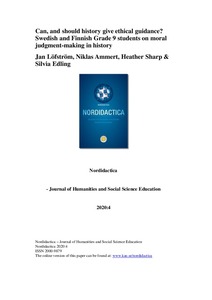Can, and should history give ethical guidance? Swedish and Finnish Grade 9 students on moral judgment-making in history
Jan Löfström; Niklas Ammert; Heather Sharp; Silvia Edling
https://urn.fi/URN:NBN:fi-fe2021042824858
Tiivistelmä
History is often invested with moral messages. When asked what history for them is, 15-year-old Europeans have strongly supported the option that history is instructive stories of good and evil, right and wrong. But what do they actually think of the potential of history as a moral guide? Do they think history can communicate what was, or would have been, the morally good choice of action in specific historic circumstances? Do they think moral questions should be discussed in a History classroom? Do young people in different countries answer these questions in the same way, and if there are differences, what are they? This paper aims to give some answers to these questions, using Swedish and Finnish Year 9 students’ responses from a survey and interviews that focused on their reasoning on moral questions in relation to history, and their ability to deal with moral dilemmas situated in a historical context. The focus is on how the students see historical knowledge as different from, or related to, moral judgment and what patterns are discernable in this respect. This is done by analysing what functions the students give to history and what arguments they use in justifying the answer. The data provides an opportunity to locate similarities and differences between Finnish and Swedish students’ responses. Tentative conclusions on the basis of the findings are discussed.
Kokoelmat
- Rinnakkaistallenteet [27094]
